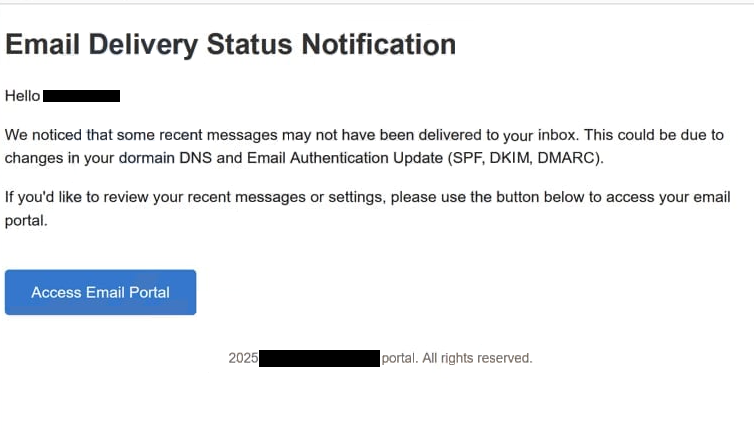Remove “Email Delivery Status Notification” email
The “Email Delivery Status Notification” email is a phishing scam designed to steal users’ email login credentials. It pretends to be an email from the email service provider, claiming that incoming emails may not have been delivered to your inbox due to potential changes to your “dormain DNS and Email Authentication Update”. The email urges recipients to click the provided button to resolve the issue. However, clicking the button leads to a phishing site that prompts you to log in with your email passwords. If you comply, your credentials are sent to the malicious actors behind this phishing campaign, potentially giving them access to your email account.
The “Email Delivery Status Notification” email informs recipients that some emails may not have been delivered. It prompts users to resolve the issue by clicking on a provided “Access Email Portal” button. However, clicking the button redirects users to a phishing website designed to replicate the email provider’s login page. If users enter their login credentials, they unknowingly provide sensitive information to cybercriminals operating the phishing campaign.
Malicious actors target email login credentials because email accounts often contain years’ worth of valuable personal data and serve as gateways to other accounts. Access to an email account enables malicious actors to misuse information for purposes such as blackmail or unauthorized access to linked accounts. Given the high value of email credentials, it is crucial for users to remain vigilant and be very cautious when logging in.
The full “Email Delivery Status Notification” phishing email is below:
Subject: Email Delivery Status Notification
Email Delivery Status Notification
Hello –
We noticed that some recent messages may not have been delivered to your inbox. This could be due to changes in your dormain DNS and Email Authentication Update (SPF, DKIM, DMARC).
If you’d like to review your recent messages or settings, please use the button below to access your email portal.
Access Email Portal2025 – portal. All rights reserved.
Signs of a phishing email
Phishing campaigns vary greatly in their level of sophistication. Less sophisticated ones are usually generic and target large numbers of users with identical, untailored emails. More advanced phishing attempts, however, target high-profile individuals or organizations, employing a degree of personalization that can make them highly convincing, even to vigilant users under the right circumstances. However, most ordinary users are unlikely to be the primary targets of such attacks. By learning to identify common warning signs, users can effectively recognize phishing emails and protect their accounts.
Always check the sender’s email address before you interact with an unsolicited email, particularly if the email prompts you to click on a link, press a button, or open an attachment. Generic phishing emails typically originate from obviously fake accounts, which can often be identified at a glance as malicious. This is the case with this “Email Delivery Status Notification” email. You can do a quick online search for the sender’s email address to confirm its authenticity. Nonetheless, some cybercriminals employ certain techniques, such as substituting letters (e.g., using “rn” instead of “m”) or adding extra characters, to make fraudulent email addresses appear legitimate. These tactics can be effective since users may not always scrutinize the details closely, which is why it’s so important that you are always careful.
Another indicator of phishing is poor grammar and spelling in emails supposedly sent from reputable senders, such as email service providers. Many phishing emails contain numerous mistakes and awkward phrasing that would be unusual for legitimate senders. For instance, this “Email Delivery Status Notification” email is riddled with glaring mistakes (e.g., “dormain” written instead of “domain”), which are a clear indication of a phishing attempt.
To avoid becoming a victim of a phishing attempt, take time to check unsolicited emails carefully. Refrain from impulsively clicking on links or opening attachments. Use anti-malware tools or services like VirusTotal to scan attachments before opening them.
“Email Delivery Status Notification” phishing email removal
If you receive this “Email Delivery Status Notification” email, disregard it entirely and do not click on anything. If you’ve already interacted with it and entered your password, change it right away if you still have access to your account. Make sure to monitor your account for any suspicious activity as well. If you find yourself locked out, use all available recovery options. If recovery efforts fail, disconnect your email from any linked accounts to protect them from potential unauthorized access.
Site Disclaimer
WiperSoft.com is not sponsored, affiliated, linked to or owned by malware developers or distributors that are referred to in this article. The article does NOT endorse or promote malicious programs. The intention behind it is to present useful information that will help users to detect and eliminate malware from their computer by using WiperSoft and/or the manual removal guide.
The article should only be used for educational purposes. If you follow the instructions provided in the article, you agree to be bound by this disclaimer. We do not guarantee that the article will aid you in completely removing the malware from your PC. Malicious programs are constantly developing, which is why it is not always easy or possible to clean the computer by using only the manual removal guide.

